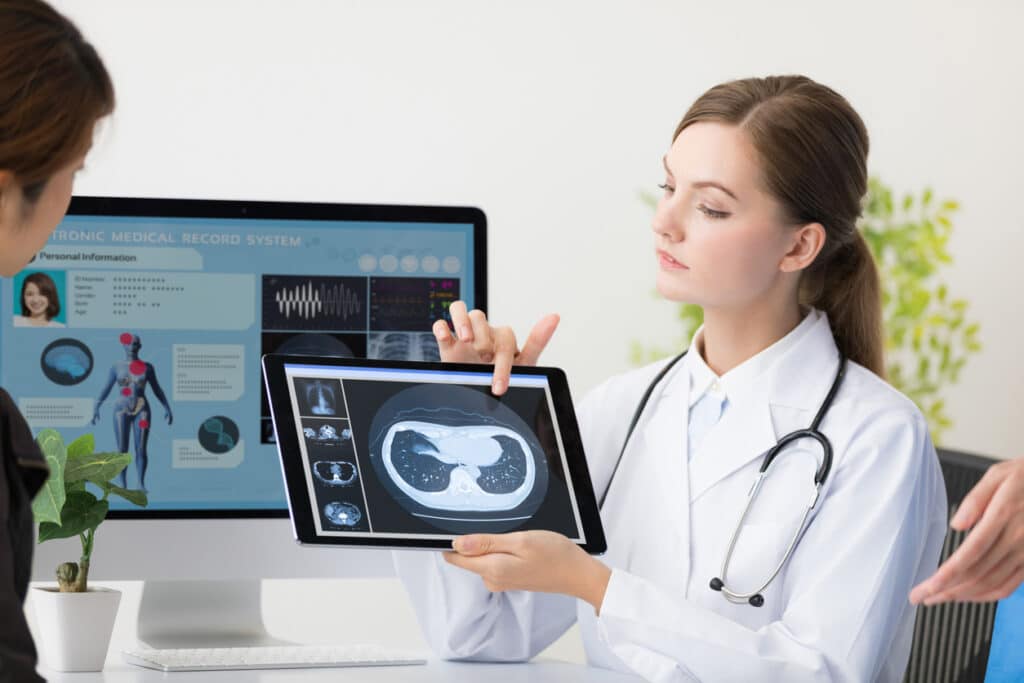Teleradiology and telemedicine have drastically transformed the healthcare industry by revolutionizing the way medical services, consultations, and diagnostics are delivered.
At the core of these advancements lies the significant role played by the Digital Imaging and Communications in Medicine (DICOM) standard.
DICOM technology has been instrumental in enabling remote access to medical images, facilitating collaboration among healthcare professionals, and improving the efficiency of patient care.
In this article, we will explore the importance of DICOM medical viewers in teleradiology and telemedicine, highlighting their functionality, features, and impact on healthcare delivery.
We will delve into the components and advantages of DICOM, discuss viewer software options, and examine the challenges and considerations surrounding their use.
By understanding the role of DICOM medical viewers, we can gain insights into how they continue to shape the future of medical imaging and its integration into modern healthcare.
Remote Access to Medical Images
One of the primary functions of DICOM medical viewers is to enable remote access to medical images.
These viewers provide radiologists and healthcare professionals with the ability to securely review images from various imaging modalities, such as X-ray, CT, MRI, and ultrasound, from any location with an internet connection.
This remote access has expanded the reach of radiology services and improved healthcare delivery.
Radiologists can now review images and provide diagnoses without being physically present at the imaging facility or hospital.
This capability is particularly valuable in situations where immediate access to radiology reports is critical for patient care, such as in emergency cases.
DICOM medical viewers have played a crucial role in bridging the gap between healthcare providers and patients by allowing for remote image review and interpretation.
Improved Collaboration Among Radiologists
DICOM viewers have facilitated better collaboration among radiologists, regardless of their geographical locations.
These viewers allow radiologists to easily share and discuss medical images with colleagues, enabling multiple experts to provide input on complex cases.
This collaborative approach leads to more accurate diagnoses and helps in selecting the most appropriate treatment plans.
Moreover, DICOM viewers have opened up new avenues for teaching and learning among radiologists.
Through the exchange of insights and expertise, radiologists can enhance their knowledge and skills, ultimately benefiting patient care.
The ability to collaborate seamlessly through DICOM medical viewers has significantly improved the accuracy and effectiveness of radiology services in teleradiology.
Enhanced Efficiency and Reduced Turnaround Time
DICOM medical viewers have streamlined the workflow of image interpretation in teleradiology, resulting in enhanced efficiency and reduced turnaround time.
With the ability to access images remotely, radiologists can expedite the diagnostic process.
These viewers enable radiologists to review images without the need for physical films or CDs, which can be time-consuming to retrieve and transport.
Rapid access to medical images through DICOM viewers allows radiologists to provide timely reports, aiding in the prompt and appropriate management of patients.
The increased efficiency and reduced turnaround time offered by DICOM medical viewers have proven to be particularly beneficial in emergency situations where quick access to radiology reports is critical for patient care.
Real-Time Consultation and Second Opinions
DICOM medical viewers empower radiologists to provide real-time consultations and second opinions to their peers and referring physicians.
These viewers enable immediate access to medical images, facilitating quick and informed decision-making in patient care.
In complex cases, seeking input from multiple experts can be invaluable in reaching an accurate diagnosis and selecting the most appropriate treatment plan.
DICOM medical viewers support the collaborative approach to patient care, ensuring that the best possible outcomes are achieved.
The ability to provide real-time consultations and second opinions through DICOM viewers has proven to be a game-changer in teleradiology, allowing for more comprehensive and well-informed patient management.
Integration with Electronic Health Records (EHRs)
DICOM medical viewers play a critical role in telemedicine by facilitating the seamless integration of medical images with Electronic Health Records (EHRs).
This integration allows healthcare providers to access a patient’s complete medical history, including diagnostic images, from a single platform.
By integrating DICOM viewers with EHRs, physicians can make more informed decisions about patient care, leading to better outcomes and enhanced patient satisfaction.
The ability to view medical images alongside other healthcare data within the EHR system improves the efficiency of telemedicine consultations and enhances patient management.
DICOM medical viewers have become an essential tool in telemedicine, enabling healthcare providers to access and review medical images within the context of a patient’s comprehensive medical record.
Remote Patient Monitoring and Diagnosis
Telemedicine relies on the ability to monitor and diagnose patients remotely.
DICOM medical viewers enable physicians to access and review medical images from any location, providing essential diagnostic information for remote patient care.
This capability is particularly valuable in rural or underserved areas where access to specialized healthcare services may be limited.
By leveraging DICOM viewers in telemedicine, healthcare providers can ensure that patients receive the necessary care regardless of their geographical location.
The ability to remotely access and review medical images through DICOM viewers expands the reach of healthcare services, improves access to specialized care, and enhances patient outcomes.
Facilitating Virtual Consultations
DICOM medical viewers support virtual consultations by allowing healthcare providers to share and discuss medical images with patients in real time.
These viewers enable physicians to visually explain their findings, diagnoses, and treatment recommendations, leading to better patient understanding and engagement.
Through virtual consultations facilitated by DICOM viewers, patients can actively participate in their healthcare decisions and gain a deeper understanding of their conditions.
The ability to visually present medical images and interact with patients in real time enhances the quality of telemedicine consultations and improves patient satisfaction.
Expanding Access to Specialized Care
DICOM viewers are instrumental in expanding access to specialized care for patients in remote or underserved areas.
By providing remote access to medical images, DICOM viewers enable patients to consult with specialists without the need for time-consuming and costly travel.
Specialists can review medical images through DICOM viewers, provide expert opinions, and collaborate with local healthcare providers to ensure comprehensive patient care.
The increased access to specialized care made possible by DICOM viewers leads to earlier diagnosis, more effective treatment, and improved health outcomes for patients in areas with limited healthcare resources.
DICOM medical viewers have bridged the gap between patients and specialists, ensuring that quality healthcare is accessible to all.
Challenges and Considerations
While DICOM medical viewers offer numerous benefits, their use in teleradiology and telemedicine comes with a set of challenges and considerations that need to be addressed.
Data Privacy and Security Concerns
The remote access and sharing of medical images facilitated by DICOM medical viewers raise concerns about data privacy and security.
Protecting patient information and ensuring its confidentiality is of utmost importance.
Healthcare organizations must implement robust security measures, such as encryption and access controls, to safeguard sensitive data from unauthorized access or potential cyberattacks.
Compliance with data protection regulations, such as the Health Insurance Portability and Accountability Act (HIPAA) in the United States or the General Data Protection Regulation (GDPR) in the European Union, is essential to maintain patient trust and protect their privacy.
Technical Infrastructure Requirements
The successful implementation of DICOM medical viewers in teleradiology and telemedicine requires a robust technical infrastructure.
Reliable, high-speed internet connections are essential for transmitting large medical image files and enabling real-time consultations.
Healthcare providers must invest in compatible hardware and software to ensure seamless integration with their existing systems.
Adequate training and technical support are necessary to ensure that healthcare professionals can effectively use DICOM viewers and maximize their benefits.
Ensuring User-Friendliness and Accessibility
For DICOM medical viewers to be widely adopted, they must be user-friendly and accessible to healthcare professionals.
Training and ongoing support can help users become proficient in DICOM viewers and unlock their full potential in teleradiology and telemedicine.
User interfaces should be intuitive and easy to navigate, allowing healthcare professionals to efficiently review and interpret medical images.
The accessibility of DICOM viewers across different devices, such as computers, tablets, and smartphones, further enhances their usability and convenience.
Legal and Regulatory Considerations
As telemedicine and teleradiology continue to grow, healthcare organizations must navigate the complex legal and regulatory landscape surrounding these services.
Compliance with regulations related to data protection, licensure, reimbursement, and medical malpractice is crucial to ensure the responsible and ethical delivery of remote healthcare services.
Healthcare providers must stay up-to-date with evolving laws and regulations to ensure compliance and provide high-quality telemedicine and teleradiology services.
Conclusion
The importance of DICOM medical viewers in teleradiology and telemedicine cannot be overstated.
These viewers enable remote access to medical images, facilitate collaboration among healthcare professionals, improve efficiency, and expand access to specialized care.
By seamlessly integrating medical images with Electronic Health Records, DICOM viewers enhance the overall quality of patient care.
However, challenges related to data privacy and security, technical infrastructure, user-friendliness, and legal considerations must be addressed to fully realize the potential of DICOM medical viewers.
As healthcare technology continues to evolve, the integration of DICOM medical viewers in teleradiology and telemedicine will play a crucial role in shaping the future of healthcare delivery and improving patient outcomes worldwide.



